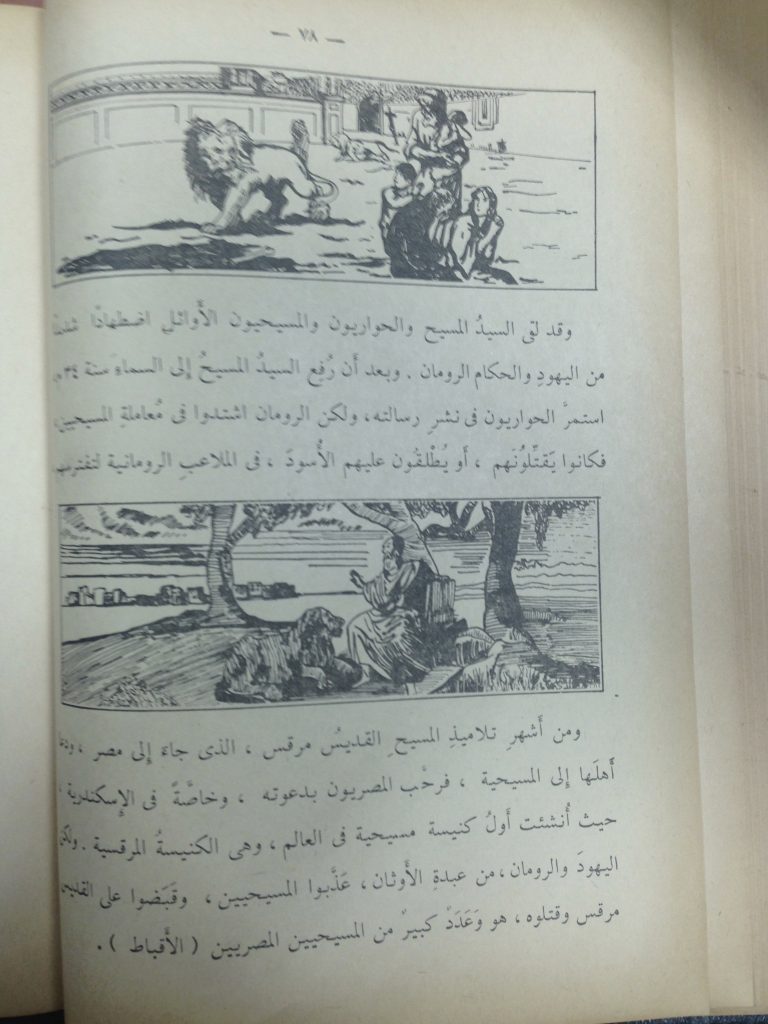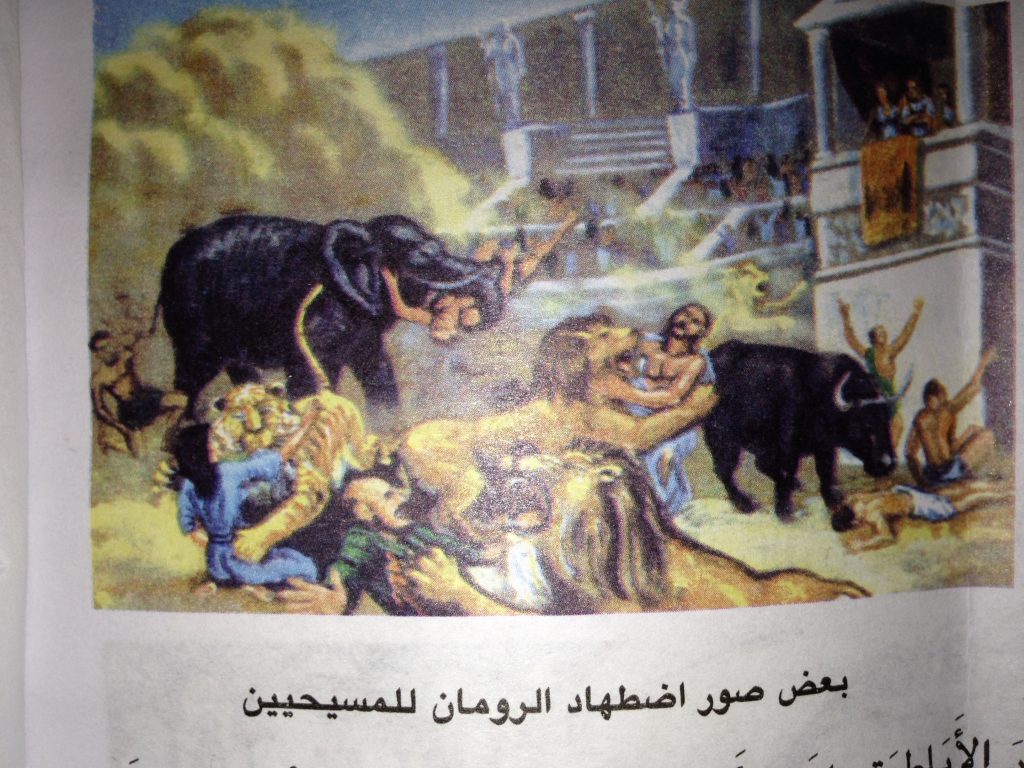By Ehaab Abdou – Mada Masr –
Over the past few years, we’ve been hearing recurring demands for the inclusion of Coptic history in textbooks, echoed in Pope Tawadros’s call to “teach Coptic history in schools.”
Sometimes it is implied, and sometimes explicitly argued, that there was a drastic curricular change that took place at a particular point in time — such as the Nasser era or the 1970s, when the Islamization of society was on the rise — before which Coptic history was more thoroughly covered. Such arguments have been put forward by some prominent scholars — such as Anwar Abdel Malek (1968) who locates these changes in the Nasser period — and continue to be propagated by several journalists and public intellectuals.
Such assertions naturally lead to simplistic demands to “include” Coptic history or increase the space allocated for it in textbooks. However, before simply demanding the inclusion of more Coptic history, we need to ask what content is to be included, and how we want that content to be presented. To be able to address these questions, I dedicate this first article to engaging with the general religious and thus exclusionary tone of these history textbooks, before turning in a second article to focus more specifically on how Copts and Coptic history are presented and ways to move forward.
The two articles are based on an analysis of all history textbooks available at the Egyptian Ministry of Education’s archives in Cairo, which go back to 1890. For ease of reference and verification by other researchers, for each textbook that I refer to, I include the serial number (SN), which refers to the unique number assigned to every textbook as listed in the archive’s catalog. For instance, a history textbook with a serial number 25 is cited as SN25, etc. As for more recent textbooks that I mention, as these are not part of the archive, I refer to their grade levels and term number in brackets (1 or 2).
There is a widely circulated misconception that the content of textbooks — like other spheres of public life in Egypt — was mainly Islamized in the 1970s. A few scholars, such as Sana S. Hasan, have challenged this by arguing that such a shift took place even earlier during Nasser’s era in the 1950s, a period that witnessed an insertion of Islamic texts and Quranic verses in several subjects, such as Arabic. In fact, such a trend is discernible in the earliest textbooks available in the Ministry of Education archives, dating back to the late 1800s.
Based on an analysis of Egyptian history textbooks from 1890 until the academic year 2016/2017, it is clear that Egyptian history is narrated from a perspective that values an Arab Muslim identity over other perspectives and voices. While the tone generally revers and paints Christianity in a positive light, the narrative as a whole is exclusionary in both explicit and subtle ways.

An 1890 textbook narrates the stories of Abrahamic prophets from a Muslim perspective with extensive citations of Quranic verses.[1] Similarly, a 1916 textbook explains how the Quran was a miracle in many ways, how it foretold events, and how it would be eternally safeguarded by God.[2] In discussing the emergence of Islam and Prophet Mohammed’s divine inspiration, a 1960 textbook asks students to memorize three Quranic verses which praise Prophet Mohammed, and that demand the obedience of the faithful to God and his Prophet.[3]
Perhaps one of the densest uses of Quranic verses appears in a 1990 textbook which includes approximately 30 Quranic verses, not only in sections related to the emergence of Islam, but throughout.[4] Current history textbooks continue to include Quranic verses and references in several sections, including referring to the Quran to confirm historical events using phrases such as: “As was stated in the Quran.”[5]
Starting in the 1900s, some history textbooks presented non-Islamic faiths in a less than favorable light. For instance, in referring to the emergence of Islam in Arabia, a 1912 textbook uses condescending terms such as the “lowly polytheism” (hudeed al-wathaneyya) when describing those practicing it, adding that Christianity and Judaism were not much better off.[6]
Similarly, in discussing reasons for why Egyptians converted to Islam, late 1940s and early 1950s textbooks made increasingly more mentions of the disillusionment with Christianity as a key motive, explaining that many Christians abandoned their religion since it had lost the path of its true values of peace and love, leading to intra-religious conflicts which killed many Christians.[7]
Perhaps one of the most striking statements appears in a 1969 textbook, which explains that because of their complexity, and the existence of several competing factions, Christianity and Judaism did not attract large numbers of followers in pre-Islamic Arabian Peninsula. The textbook further explains that despite such shortcomings, at least these “external religions” (al-diyanat al-kharijia) and their teachings served a purpose by somehow paving the way for people to later accept the teachings of Islam.[8]
Other textbooks allude to the influence of ancient Greek philosophies, which rendered Judaism and Christianity more complicated and less accessible to ordinary people.[9]
Fortunately, such negative depictions are not found in current textbooks. In fact, there have also consistently been some positive references to Christianity and its refined values, especially vis-à-vis ancient polytheistic religions. For instance, some textbooks from the 1930s and 1940s refer to Christianity having had a more enduring and longer lasting influence than ancient Roman laws or ancient Greek and Latin literature.[10]

However, a general and pervasive Islamic tone and an Arab Muslim perspective has dominated Egyptian history textbooks ever since the late 1800s.
Current history textbooks do not include explicit derogatory references to Christianity or Christians — as some of the earlier textbooks did. In fact, they include extremely positive mentions, albeit concise. For instance, in explaining why ancient Egyptians embraced Christianity, a 2016 textbook explains that they were attracted by its values of justice, equality, mercy, empathy, tolerance, renouncement of worldly pleasures, and valuing of the afterlife.[11]
However, we need to also be cognizant of more subtle ways that might give value to one identity while diminishing or silencing others. In addition to continuing to use explicit and extensive Muslim referents as highlighted above, more subtle exclusions can also be found in current textbooks. For instance, they use the word “Arab” to characterize countries such as Egypt and Lebanon even before they had been taken over by Arab Muslim armies. Such references give the historically inaccurate and false impression that these countries have always embraced an Arab identity, eclipsing the richness of their pre-existing civilizations and cultures.[12]
Additionally, several of these history textbooks have continued to address students as if they are all Muslim. For instance, an 1893 history textbook explains that the religious story of David and his son Solomon “must be learned by all Muslims.”[13] Similarly, a 1988 history textbook encourages students to learn about the annual Muslim pilgrimage to Mecca by asking their relatives who might have performed it.[14] In discussing civic engagement, current textbooks encourage students to be proud of our Islamic principles and values that encourage us to volunteer in the community and peacefully co-exist with others different from ourselves.[15]
By leaving out other religions or identities and devaluing them, such an exclusionary tone and perspective excludes people belonging to those other religions or embracing those identities. In addition to alienating non-Muslim students, such a tone may also alienate non-Sunni Muslim and non-religious Muslim students at large.
Due to different pressures, the Ministry of Education recently removed some content about controversial early Muslim historical figures such as Uqba ibn-Nafie or Saladin from Arabic language textbooks.
However, beyond such additions or removals of potentially controversial material, we need to examine the overall tone and perspective of how Egyptian history is presented in textbooks. As well as examining these explicit texts, we must also analyse the subtle ways that obscure or silence diversity or give prominence to particular dimensions of Egyptian identity over others.
In the next article, I focus more specifically on challenges related to the portrayal of the Coptic era, Copts, and their historical contributions, charting some suggestions based on inspiring examples from earlier history textbooks. However, it is worth noting here that my archival analysis revealed that while the question of Coptic history is an extremely important and timely one, ultimately, what is needed is a dialogue about Egyptian history education and the inclusion of the many missing narratives and perspectives. Those not only include silenced historical narratives of different minorities but should extend to include narratives of the Egyptian people at large, who are often excluded by the textbooks’ current focus on elites and rulers.
—
I accessed the archive between January and March 2017 and am grateful to the team working there for their professional support and hospitality.
I would like to thank the Mada Masr editorial team, as well as the following individuals for their extremely helpful insights and critical feedback on earlier versions of these two pieces: Farida Makar, Hadil Ghoneim, Mona Makramalla, Maha Bali and Joyce Rafla.
—
[1] SN250 [2] SN12, p. 35, p. 62 [3] SN79, p. 112 [4] SN376 [5] Grade 8(1), 2013, pp. 34-35 [6] SN268, p. 81 [7] SN342, 1949, p. 91; SN201, 1954 p. 115; SN210, 1957, p. 78 [8] SN369, p. 32 [9] SN205, 1955, p. 27; SN369, 1969, p. 63 [10] SN272, 1930, p. 157; SN285, 1940, p. 237 [11] Grade 7(2), p. 57 [12] e.g., Grade 7(2), 2013, p. 34 [13] SN 3, p. 206 [14] SN167, p. 156 [15] e.g., Grade 8(2), 2016, p. 67______________
https://www.madamasr.com/en/2017/09/22/feature/society/copts-in-egyptian-history-textbooks-since-1890-part-1-are-we-asking-the-right-questions/amp/





